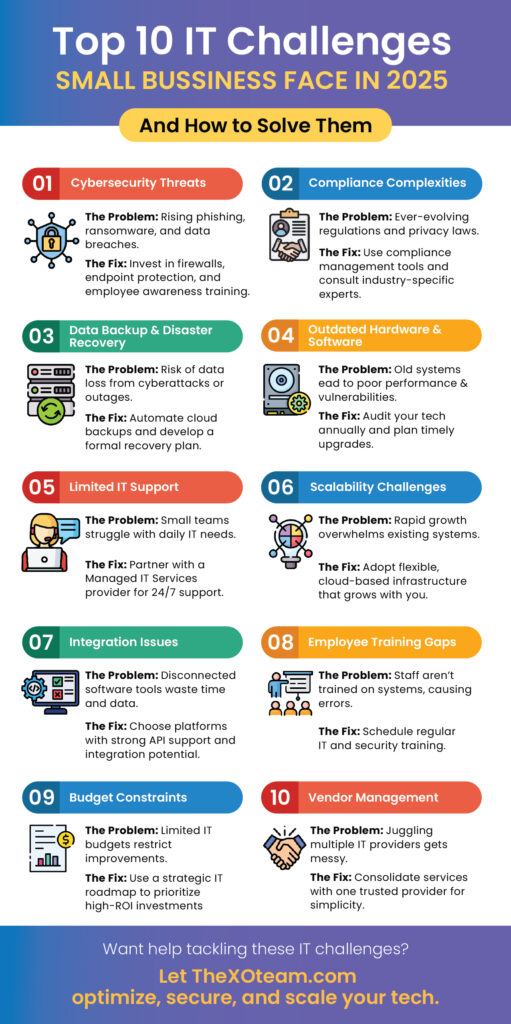In today’s digital-first world, technology is the backbone of nearly every small business. Whether you’re running a cannabis dispensary, a local retail shop, or a professional services firm, your IT infrastructure plays a critical role in everything, from customer experience to compliance and growth.
But with rapid technological changes come new and evolving challenges. In 2025, small businesses face a complex IT landscape filled with security threats, integration issues, compliance demands, and budget limitations. Ignoring these can lead to lost productivity, data breaches, fines, or even total business disruption.
Here are the top 10 IT challenges small businesses face in 2025, and how to tackle them head-on.

1. Cybersecurity Threats Are Getting More Aggressive
Small businesses have become prime targets for cyberattacks, largely because they often lack the robust defenses that larger enterprises have. From ransomware and phishing scams to insider threats and credential stuffing, the risk is real and constantly growing.
How to Solve It:
- Deploy firewalls, antivirus software, and endpoint detection.
- Use multi-factor authentication (MFA) across all critical systems.
- Regularly patch and update software to close vulnerabilities.
2. Compliance Requirements Are More Complex Than Ever
From GDPR and HIPAA to state-specific cannabis regulations, compliance rules are tightening across industries. Falling behind can result in steep fines, legal consequences, and reputational damage.
How to Solve It:
- Implement IT systems that track and document compliance.
- Use cloud services that are certified for your industry (e.g., SOC 2, HIPAA-compliant platforms).
- Consult with IT and legal experts to stay ahead of changing regulations.
- Document your compliance efforts and conduct regular audits.
3. Data Backup & Disaster Recovery Plans Are Often Inadequate
Power outages, ransomware, hardware failure, or even a natural disaster can wipe out your data if you’re not prepared. And without fast recovery options, every hour offline is money lost.
How to Solve It:
- Automate daily or hourly backups to the cloud.
- Test your disaster recovery plan regularly to ensure it works in real-world scenarios.
- Maintain both on-site and off-site backup solutions for redundancy.
- Consider business continuity planning as part of your IT strategy.
4. Outdated Hardware and Software Are Holding You Back
Many small businesses delay replacing old hardware or renewing software licenses to save money, but this often results in poor system performance, downtime, and increased vulnerability to threats.
How to Solve It:
- Perform regular tech audits to identify aging equipment or unsupported software.
- Lease hardware to avoid upfront costs while keeping equipment current.
- Move from legacy software to scalable SaaS platforms when possible.
- Implement an IT lifecycle management strategy to ensure timely upgrades.
5. Limited or No IT Support Leads to Costly Delays
Small business teams are often spread thin, with IT responsibilities falling on someone who’s not trained in tech. When something breaks, you’re left scrambling to fix it.
How to Solve It:
- Partner with a Managed IT Services provider like the team XO for 24/7 helpdesk support, system monitoring, and strategic IT planning.
- Choose a provider that understands your industry and its unique requirements.
- Free your internal team to focus on core business tasks by outsourcing day-to-day IT management.
6. Scalability Is an Afterthought, Until It’s Too Late
Success can be your downfall if your IT systems can’t keep up. Adding more locations, products, or users can put strain on poorly designed infrastructure.
How to Solve It:
- Use cloud-based solutions that scale on demand.
- Adopt modular systems for POS, security, and inventory management.
- Plan ahead with IT architecture that supports growth, not just current needs.
- Monitor system performance regularly to identify growth limitations early.
7. Integration Issues Waste Time and Create Data Silos
Most small businesses use multiple software tools like POS systems, accounting platforms, CRMs, and marketing software. If these don’t talk to each other, you lose time and risk inconsistent data.
How to Solve It:
- Select tools that integrate natively or via APIs.
- Work with IT consultants to build custom integrations when needed.
- Centralize data through platforms like ERP or cloud-based dashboards.
- Avoid vendor lock-in by choosing systems that can grow with your business.
8. Employees Aren’t Properly Trained on Tech Tools
You could have the best tech stack in the world, but if your staff doesn’t know how to use it properly, productivity takes a hit. Worse yet, untrained employees often fall for phishing scams or mishandle sensitive data.
How to Solve It:
- Offer regular onboarding and refresher training on software tools, cybersecurity, and compliance practices.
- Use role-based access control so users only see the systems they need.
- Create easy-to-follow SOPs for IT-related workflows.
- Encourage a culture of asking for help, not guessing.
9. Budget Constraints Lead to Poor IT Decisions
Many small business owners are forced to make difficult financial choices, and IT is often pushed to the back burner. This creates a cycle of technical debt that’s costly and difficult to escape.
How to Solve It:
- Create a realistic IT budget based on business goals, not just immediate needs.
- Use a phased investment approach for major upgrades.
- Explore government grants, tax deductions, and IT leasing options.
- Work with a Managed Services provider to get enterprise-level support at a fraction of the cost.
10. Too Many Vendors Leading to Too Much Complexity
Managing multiple vendors for networking, cloud storage, POS systems, and cybersecurity often leads to gaps, finger-pointing, and increased costs.
How to Solve It:
- Consolidate IT services under a single provider to improve coordination and accountability.
- Choose partners who offer full-stack services, from infrastructure and support to compliance and surveillance.
- Ensure vendor SLAs are clearly defined and regularly reviewed.
Final Thoughts: Be Proactive, Not Reactive
In today’s fast-evolving tech landscape, IT is no longer just support — it’s the engine behind innovation, growth, and security. For small and regulated businesses, managing IT the right way can mean reduced risks, lower costs, and a serious edge over the competition.
That’s where XO comes in. From managed IT services to cybersecurity, we help you take control of your technology and future-proof your operations.
Struggling with IT challenges? Let’s solve them — together.
Schedule your free consultation today or explore our full suite of services on our website.




